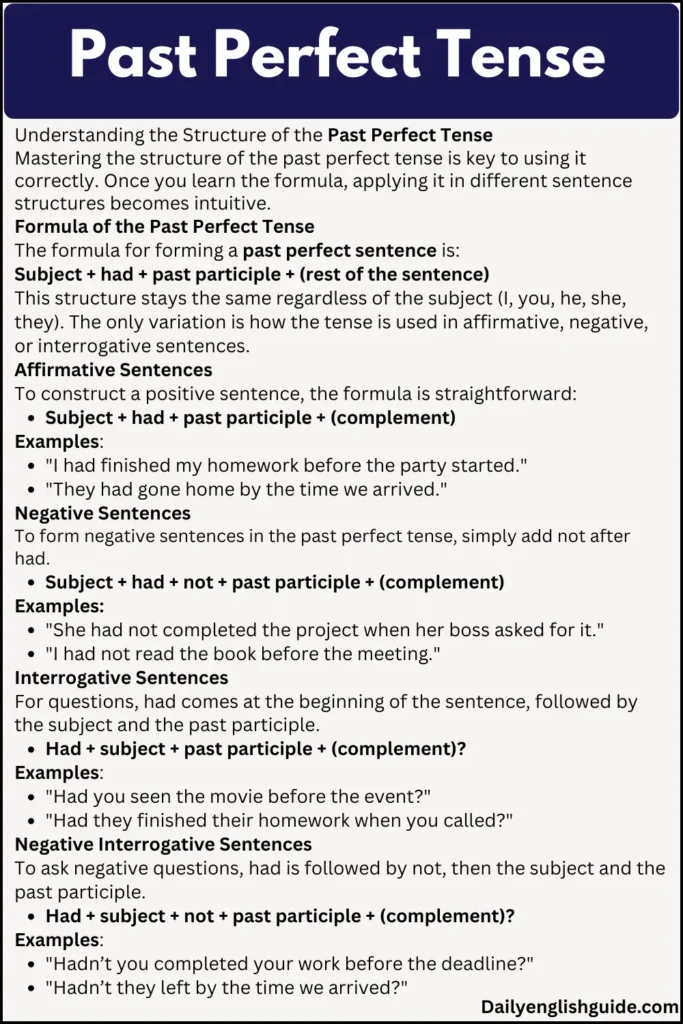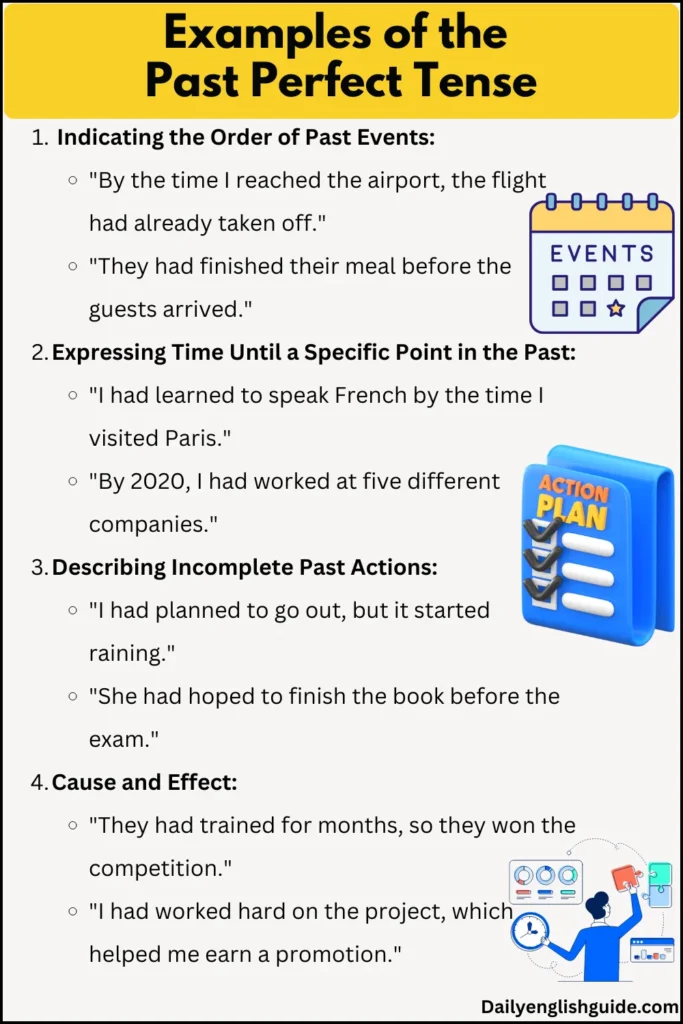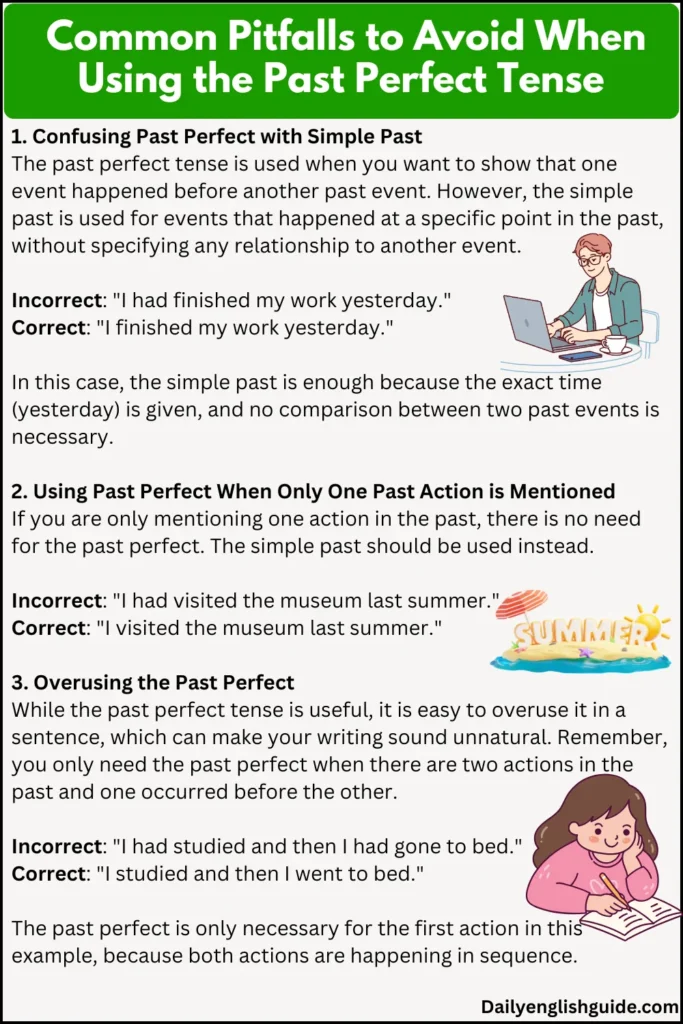The past perfect tense can be a powerful tool for improving your grammar and writing skills. By expressing actions that were completed before another action in the past, the past perfect provides clarity and structure to narratives, timelines, and historical recounts. Whether you’re telling a story or explaining events, understanding and mastering the past perfect tense will make your communication more precise and effective.
What Is the Past Perfect Tense?
The past perfect tense refers to an action that was completed before another action or event in the past. In other words, it shows the sequence of past events by emphasizing that one action was already finished before another occurred. It is an essential part of narrating events and ensures that your listeners or readers follow the timeline clearly.
Consider the following definitions:
-
Cambridge Dictionary: “The form of a verb used to show that an action had already finished when another action happened.”
-
Oxford Learner’s Dictionary: “The form of a verb that expresses an action completed before a particular point in the past, formed in English with ‘had’ and the past participle.”
-
Merriam-Webster Dictionary: “The form of the verb that is used when referring to an action that was completed by a particular time in the past.”
-
Collins Dictionary: “A tense indicating an action as completed or a state as having ended before a specified or implied time in the past, also referred to as the ‘pluperfect.'”
These definitions point to a core principle: the past perfect tense focuses on an action completed prior to another event or point in time, helping clarify the order of events in the past.

Understanding the Structure of the Past Perfect Tense
Mastering the structure of the past perfect tense is key to using it correctly. Once you learn the formula, applying it in different sentence structures becomes intuitive.
Formula of the Past Perfect Tense
The formula for forming a past perfect sentence is:
Subject + had + past participle + (rest of the sentence)
This structure stays the same regardless of the subject (I, you, he, she, they). The only variation is how the tense is used in affirmative, negative, or interrogative sentences.
Affirmative Sentences
To construct a positive sentence, the formula is straightforward:
-
Subject + had + past participle + (complement)
Examples:
-
“I had finished my homework before the party started.”
-
“They had gone home by the time we arrived.”
Negative Sentences
To form negative sentences in the past perfect tense, simply add not after had.
-
Subject + had + not + past participle + (complement)
Examples:
-
“She had not completed the project when her boss asked for it.”
-
“I had not read the book before the meeting.”
Interrogative Sentences
For questions, had comes at the beginning of the sentence, followed by the subject and the past participle.
-
Had + subject + past participle + (complement)?
Examples:
-
“Had you seen the movie before the event?”
-
“Had they finished their homework when you called?”
Negative Interrogative Sentences
To ask negative questions, had is followed by not, then the subject and the past participle.
-
Had + subject + not + past participle + (complement)?
Examples:
-
“Hadn’t you completed your work before the deadline?”
-
“Hadn’t they left by the time we arrived?”
When to Use the Past Perfect Tense
Understanding when to use the past perfect tense is just as important as knowing how to form it. Below are some key scenarios in which the past perfect tense is most commonly used:
-
Indicating the Order of Two Past Events: When two actions occur in the past, but one happens before the other, the past perfect helps clarify the sequence of events.
-
Example: “When I arrived at the party, my friends had already left.”
-
-
Denoting Time Until a Certain Point in the Past: The past perfect can express an action that was completed by a specific time in the past.
-
Example: “She had finished the report by the time her manager arrived.”
-
-
Describing an Incomplete Action in the Past: Sometimes, the past perfect is used to show that an action was incomplete when another event happened in the past.
-
Example: “The movie had already started when we got to the theater.”
-
-
Highlighting the Cause or Effect: The past perfect can also be used to show that one event caused another to happen.
-
Example: “He had studied hard, so he passed the exam easily.”
-
Common Mistakes with the Past Perfect Tense
The past perfect tense can be tricky, especially when it’s confused with other tenses. Here are some common mistakes to watch out for:
-
Using Past Perfect Unnecessarily: Sometimes, people overuse the past perfect tense when the simple past tense is sufficient. For example, saying “I had visited the store yesterday” is incorrect; it should be “I visited the store yesterday.”
-
Confusing Past Perfect with Present Perfect: The past perfect tense refers to actions that were completed before a certain point in the past, while the present perfect tense describes actions that have relevance to the present. For example:
-
Past Perfect: “I had eaten lunch before you called.”
-
Present Perfect: “I have eaten lunch already.”
-
-
Using Incorrect Past Participles: It’s crucial to use the correct past participle form of verbs. For instance, “I had went to the store” is incorrect. It should be “I had gone to the store.”

More Examples of the Past Perfect Tense
Here are more examples to help you grasp how the past perfect tense is used:
-
Indicating the Order of Past Events:
-
“By the time I reached the airport, the flight had already taken off.”
-
“They had finished their meal before the guests arrived.”
-
-
Expressing Time Until a Specific Point in the Past:
-
“I had learned to speak French by the time I visited Paris.”
-
“By 2020, I had worked at five different companies.”
-
-
Describing Incomplete Past Actions:
-
“I had planned to go out, but it started raining.”
-
“She had hoped to finish the book before the exam.”
-
-
Cause and Effect:
-
“They had trained for months, so they won the competition.”
-
“I had worked hard on the project, which helped me earn a promotion.”
-
Understanding the Nuances of the Past Perfect Tense
The past perfect tense often appears in sentences where you need to show the relationship between two past actions, ensuring that your listeners or readers understand which event happened first. This is especially useful in narrative writing or any context where you’re describing historical events or personal experiences in a sequential manner.
For example:
-
“She had finished her work when the phone rang.”
-
“They had already left by the time I called.”
This structure can also be used in reported speech when conveying something that happened before another event:
-
“John said he had already completed the assignment.”
The past perfect tense can even be used in conditional sentences:
-
“If I had known about the party, I would have attended.”
How to Form and Use the Past Perfect Tense in Different Contexts
Now that we’ve covered the basics of the past perfect tense, it’s time to dive deeper into its practical applications. The past perfect tense is not just for academic writing or formal documents but can be used in everyday speech, storytelling, and narratives. Here are some specific contexts where you’ll find the past perfect tense most useful:
1. In Storytelling and Narratives
When narrating events in the past, the past perfect tense helps clarify the sequence of actions. In any story, you may need to explain that one event occurred before another, and the past perfect tense is the most appropriate tool for that.
Example:
-
“I had just left the house when it started to rain.”
-
“By the time we reached the theater, the movie had already started.”
In these examples, the past perfect tense makes the relationship between the actions clear: the action of “leaving the house” happened before “it started to rain” and “reaching the theater” happened before “the movie started.”
2. In Conditional Sentences (Third Conditional)
The past perfect tense is frequently used in third conditional sentences to express hypothetical situations in the past—those that didn’t actually happen.
Structure of Third Conditional:
-
If + past perfect, subject + would have + past participle.
Examples:
-
“If I had known about the meeting, I would have attended.”
-
“If they had worked harder, they would have passed the exam.”
These sentences show that the actions didn’t happen, but they are hypothetical outcomes that would have been possible under different circumstances.
3. In Reported Speech
The past perfect tense is also commonly used in reported speech when quoting what someone said about a past event that had already been completed before the report was made.
Example:
-
“She told me that she had finished the project before the deadline.”
-
“He said that they had already left when he arrived.”
In these cases, the past perfect tense helps convey the completion of an action that happened before another action took place in the past.
4. In Time Clauses
The past perfect is often used in time clauses that explain the relationship between two actions or events. This can be especially helpful when providing background information before moving on to the main events of a story.
Examples:
-
“After I had finished my homework, I went out with friends.”
-
“When the meeting had ended, everyone left the room.”
By using the past perfect, the first action is clearly established as having been completed before the second action took place.
5. In Describing Historical Events
The past perfect tense is invaluable when describing historical events or life experiences where it is important to emphasize the completion of one event before another. This is a common structure in historical writing or biographies.
Examples:
-
“By the time World War II ended, many countries had already begun rebuilding.”
-
“By the 18th century, scientists had already discovered the laws of gravity.”
In these cases, the past perfect provides a clear timeline of events that occurred before others in the same historical period.
6. In Expressing Regret (with “wish” or “if only”)
When talking about things you wish had been different in the past, the past perfect tense is often used. This structure often involves “wish” or “if only” to express regret about something that didn’t happen.
Examples:
-
“I wish I had studied harder for the exam.”
-
“If only she had told me the truth, I would have understood.”
Here, the past perfect tense is used to express a missed opportunity or something that could have been but wasn’t.

Common Pitfalls to Avoid When Using the Past Perfect Tense
While the past perfect tense is a powerful tool for expressing past actions in relation to one another, it’s easy to make mistakes, especially when you’re still getting used to it. Here are some common pitfalls to avoid:
1. Confusing Past Perfect with Simple Past
The past perfect tense is used when you want to show that one event happened before another past event. However, the simple past is used for events that happened at a specific point in the past, without specifying any relationship to another event.
Incorrect: “I had finished my work yesterday.”
Correct: “I finished my work yesterday.”
In this case, the simple past is enough because the exact time (yesterday) is given, and no comparison between two past events is necessary.
2. Using Past Perfect When Only One Past Action is Mentioned
If you are only mentioning one action in the past, there is no need for the past perfect. The simple past should be used instead.
Incorrect: “I had visited the museum last summer.”
Correct: “I visited the museum last summer.”
3. Overusing the Past Perfect
While the past perfect tense is useful, it is easy to overuse it in a sentence, which can make your writing sound unnatural. Remember, you only need the past perfect when there are two actions in the past and one occurred before the other.
Incorrect: “I had studied and then I had gone to bed.”
Correct: “I studied and then I went to bed.”
The past perfect is only necessary for the first action in this example, because both actions are happening in sequence.
4. Mixing Up Past Participles
The past perfect tense requires the past participle form of the verb. Be careful not to confuse the past simple and past participle forms of irregular verbs.
Incorrect: “I had ate dinner already.”
Correct: “I had eaten dinner already.”
Irregular verbs often have unique past participle forms, so make sure you’re familiar with them to avoid mistakes.
Quick Recap of Key Points
-
The past perfect tense expresses an action completed before another past action.
-
The structure follows: Subject + had + past participle + complement.
-
Use the past perfect in narratives, conditionals, reported speech, and time clauses to clarify the sequence of past events.
-
Be cautious of common mistakes such as confusing the past perfect with the simple past or overusing the tense.
